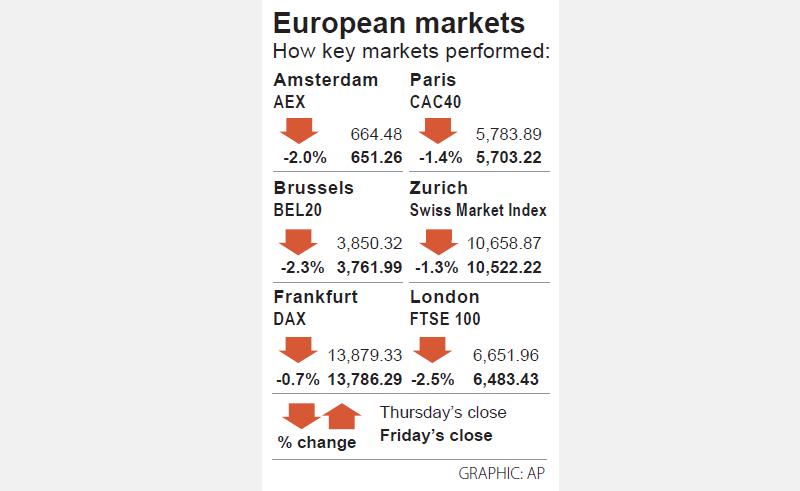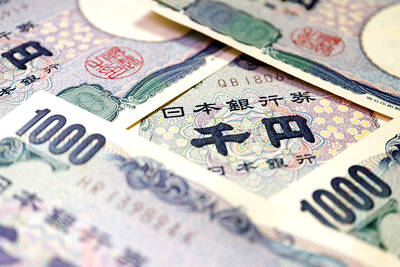European stocks on Friday closed lower, ending three weeks of gains as investors booked profits in technology and commodity-linked shares due to concerns over rising inflation and interest rates on the back of a jump in bond yields.
The benchmark STOXX 600 fell 1.64 percent to 404.99 and shed 2.38 percent for the week — its first weekly loss this month — with technology stocks losing the most as they continued to retreat from 20-year highs.
On the day, resource stocks were the softest-performing European sectors, tumbling 4.2 percent from a near 10-year high in their worst session in five months.

“Equity markets across the US and Europe are quite expensive now, and with bond yields constantly rising, the fixed income market is proving to be more attractive than the riskier equity market,” Societe Generale SA strategist Roland Kaloyan said. “Investors are actually looking at the pace at which yields drop and the current speed is quite concerning for equity markets.”
US and eurozone bond yields retreated slightly, but stayed close to highs hit this week as investors positioned for higher inflation this year. Yields were also set for large monthly gains.
BETTER RETURNS
Sectors such as utilities, healthcare and other staples — usually seen as proxies for government debt due to their similar yields — lagged their European peers for the month as investors sought better returns from actual debt.
Still, the STOXX 600 has gained this month, helped by a rotation into energy, banking and mining stocks on expectations of a pickup in business activity following COVID-19 vaccine rollouts.
Travel and leisure was the strongest sector this month as investors bet on an economic reopening boom. Banks also outperformed their peers thanks to higher bond yields.
Better-than-expected fourth-quarter earnings have also reinforced optimism about a quicker corporate rebound this year.
Of the 194 companies in the STOXX 600 that have reported quarterly earnings so far, 68 percent have beaten analysts’ estimates, according to Refinitiv.
In London, the export-heavy FTSE 100 marked its weakest session since late October last year, snapping three straight weeks of gains.
MINING STOCKS DOWN
The FTSE 100 slipped 2.53 percent to 6,483.43, declining 2.12 percent from a week earlier.
Mining stocks, including Rio Tinto Group, Anglo American PLC and BHP, were the biggest drags on the index, while oil heavyweights BP PLC and Royal Dutch Shell fell, tracking a decline in oil and metal prices.

GROWING OWINGS: While Luxembourg and China swapped the top three spots, the US continued to be the largest exposure for Taiwan for the 41st consecutive quarter The US remained the largest debtor nation to Taiwan’s banking sector for the 41st consecutive quarter at the end of September, after local banks’ exposure to the US market rose more than 2 percent from three months earlier, the central bank said. Exposure to the US increased to US$198.896 billion, up US$4.026 billion, or 2.07 percent, from US$194.87 billion in the previous quarter, data released by the central bank showed on Friday. Of the increase, about US$1.4 billion came from banks’ investments in securitized products and interbank loans in the US, while another US$2.6 billion stemmed from trust assets, including mutual funds,

AI TALENT: No financial details were released about the deal, in which top Groq executives, including its CEO, would join Nvidia to help advance the technology Nvidia Corp has agreed to a licensing deal with artificial intelligence (AI) start-up Groq, furthering its investments in companies connected to the AI boom and gaining the right to add a new type of technology to its products. The world’s largest publicly traded company has paid for the right to use Groq’s technology and is to integrate its chip design into future products. Some of the start-up’s executives are leaving to join Nvidia to help with that effort, the companies said. Groq would continue as an independent company with a new chief executive, it said on Wednesday in a post on its Web

RESPONSE: The Japanese Ministry of Finance might have to intervene in the currency markets should the yen keep weakening toward the 160 level against the US dollar Japan’s chief currency official yesterday sent a warning on recent foreign exchange moves, after the yen weakened against the US dollar following Friday last week’s Bank of Japan (BOJ) decision. “We’re seeing one-directional, sudden moves especially after last week’s monetary policy meeting, so I’m deeply concerned,” Japanese Vice Finance Minister for International Affairs Atsushi Mimura told reporters. “We’d like to take appropriate responses against excessive moves.” The central bank on Friday raised its benchmark interest rate to the highest in 30 years, but Bank of Japan Governor Kazuo Ueda chose to keep his options open rather than bolster the yen,

Even as the US is embarked on a bitter rivalry with China over the deployment of artificial intelligence (AI), Chinese technology is quietly making inroads into the US market. Despite considerable geopolitical tensions, Chinese open-source AI models are winning over a growing number of programmers and companies in the US. These are different from the closed generative AI models that have become household names — ChatGPT-maker OpenAI or Google’s Gemini — whose inner workings are fiercely protected. In contrast, “open” models offered by many Chinese rivals, from Alibaba (阿里巴巴) to DeepSeek (深度求索), allow programmers to customize parts of the software to suit their